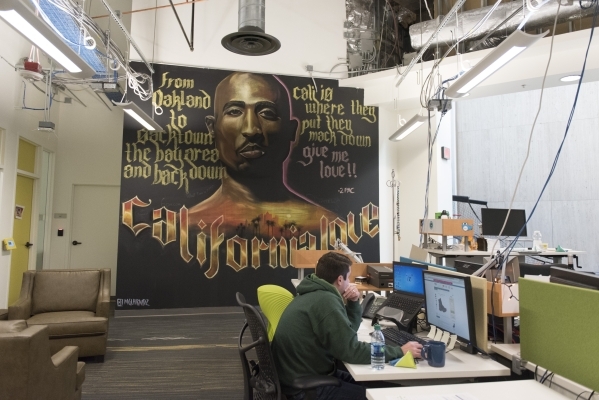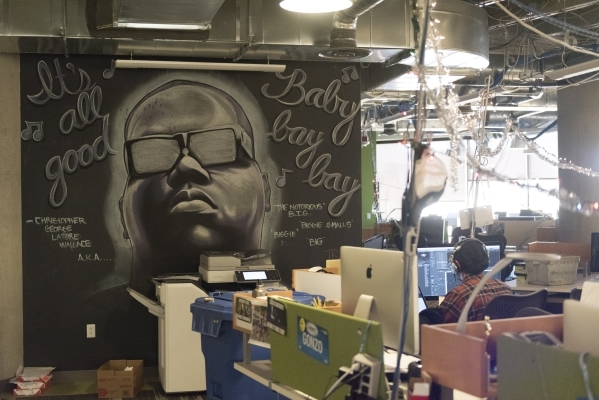Zappos.com thriving — minus the bosses plus the dogs
Back in the day when managers and "leads" roamed the Zappos.com headquarters, it would have been a mighty feat to allow workers to have dogs at their desks at the online shoe and clothing retailer.
Zappos worker Tyler Williams said it would have meant human resources, legal, safety and campus operations all getting involved. In other words, management red tape.
But Williams helped get the ball rolling for workers to have their canine friends at their work stations after Zappos CEO Tony Hsieh last year incorporated a new management approach called "holacracy" — a boss-free workplace where workers manage themselves.
"I was able to begin opening particular places around the campus for dogs by polling the areas for allergies/fears, and developing best practices around employees bringing their dogs," Williams recalled. "Since I have no actual dog expertise, I worked with Hydrant Club downtown to assess the dogs prior to coming on campus."
The dog story is just one of myriad examples of workers having more power to spark and influence decisions after Hsieh made his downtown Las Vegas Zappos hub and its 1,500 workers a manager-free zone.
Unleashed from answering to a supervisor, workers now can weigh in and influence any decision, issue, topic or subject at Zappos. The "legacy management hierarchy," as Hsieh called it, was retired April 30.
"Anything that happens at Zappos is up for evolution or change," said John Bunch, technical adviser to the CEO who has led the company's transition to holacracy.
Hsieh wanted Zappos to be free of bosses because he wanted an organization that could be nimble and adaptable to the changes necessary to realize a successful workplace for employees while also making it a profitable business. Zappos is owned by Amazon, and its finances are lumped in with those of the parent so there's no way for outsiders to tell how well the new approach is working for the company.
"There is a low bar for making changes," Bunch said. "We want to be a quick, agile and adaptable organization and to do that you have to lower the bar to change."
The notion that workers would self-manage themselves lead workplace traditionalists to speculate that chaos and anarchy would reign at Zappos.
That hasn't happened, Bunch said.
First, there's an official holacracy constitution that outlines the system.
Second, workers function as "sensors" to police themselves if a fellow employee comes up with an idea that is far from ideal.
Third, workers account for their various duties by showing how much time they spend on different roles at work. The percentage breakdown of how workers spend their time can be seen on the company's computer program.
The new system is like learning a new language, Hsieh said.
"The analogy I would use would be if we moved everyone from the U.S. to Spain because we believed that Spain would be the best environment for the company long-term, but very few employees spoke Spanish. Some employees pick up Spanish very quickly, whereas others take longer to adopt," Hsieh said.
"But it's also hard to practice your Spanish if you're only able to talk to other employees who have varying levels of Spanish-speaking skills. And even after you learn the basic vocabulary of Spanish, it may take some time before you're able to read and write beautiful Spanish poetry," he said.
Hsieh also used poker as an analogy: "It's relatively quick and easy to learn the rules of poker, but to be a really good poker player takes time and skill."
Hsieh places a big emphasis on workplace culture. Granting workers more power is effective for employees who have Zappos' back, he said.
"For employees (who) have the company's best interests at heart, the additional power enables employees to break away from many of the restrictions that existed under the prior structure," he said.
"If someone does not have the company's best interests at heart, holacracy also enables that hypothetical person to do more damage compared to the prior structure," Hsieh said. "I think what's been interesting and surprising is that as a result, company culture is now more important than ever."
Workers who wanted to leave because they were not comfortable with holacracy were able to quit with severance packages this year.
A total of 206 Zappos workers took the severance deal, but only 68 informed the company that they left because of holacracy.
"In talking to various employees who took the offer and reading their exit interviews, my guess was at least half of them took the offer for reasons that had nothing to do with holacracy (such as taking time off to take care of a sick parent, or using the money from the offer to pursue their entrepreneurial dreams, or just taking a year off with the intention of rejoining zappos after a year)," Hsieh wrote in an email.
"The offer was for a minimum of three months salary or one month for every year worked. We've had some employees that have been with us for over 12 years, so they were able to receive one year's salary and still can reapply to join Zappos one year later," Hsieh said.
Contact reporter Alan Snel at asnel@reviewjournal.com Find him onTwitter: @BicycleManSnel


























